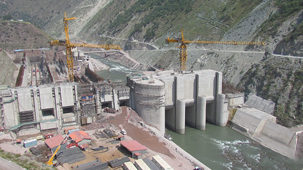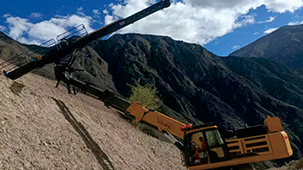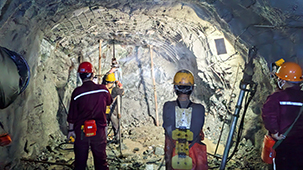Micropiles vs. Soil Nailing: A Comparative Analysis
Time:2025-02-14From:sinorock View:
Ground improvement techniques are vital for ensuring the stability and longevity of construction projects, particularly when dealing with challenging soil conditions. Among these techniques, micropiles and soil nailing have gained significant recognition for their ability to reinforce foundations and stabilize slopes. This article offers an in-depth comparative analysis of these two techniques, covering their construction processes, advantages, limitations, and ideal applications.As geotechnical engineering continues to evolve, both micropiles and soil nailing serve as crucial tools in ground stabilization and foundation support. Whether you're dealing with a complex foundation design or slope stabilization, understanding the differences between these techniques is essential for making the best choice for your project.
What Are Micropiles?
Micropiles, also referred to as mini-piles or pin piles, are small-diameter, high-strength steel reinforcement elements. These piles are installed using specialized drilling methods to anchor structures to competent load-bearing strata deep below the ground surface. With diameters typically ranging from 100 mm to 300 mm, micropiles are ideal for applications that require deep foundation support in areas where traditional piling methods are not feasible.
The construction process for micropiles involves rotary or vibro-drilling techniques, followed by the insertion of steel reinforcement elements and pressure grouting to improve soil-structure interaction. This combination of advanced drilling and grouting enhances the load transfer between the pile and surrounding soil, resulting in a highly effective ground reinforcement method.

Applications of Micropiles:
- Foundation underpinning for buildings and bridges
- Slope stabilization and erosion control
- Retaining wall construction
- Seismic retrofitting and reinforcing structures in earthquake-prone areas
Advantages of Micropiles
1. Increased Load-Bearing Capacity:
Micropiles are specifically designed to bear significant vertical and horizontal loads. Pressure grouting helps improve soil properties around the pile, which can significantly increase the load-bearing capacity of the micropile. This makes them particularly useful for projects that demand reliable foundation support in challenging soil conditions.
2. Versatility:
Micropiles are suitable for a wide range of applications, from underpinning foundations in existing structures to stabilizing slopes and even retrofitting buildings in seismic zones. Their flexibility makes them an ideal choice for diverse construction projects.
3. Minimal Disturbance:
The drilling process for micropiles creates minimal disruption to the surrounding environment, making them particularly useful in urban areas, sensitive ecosystems, or congested sites. This low-impact installation process ensures that nearby structures and soil conditions remain undisturbed.
Limitations of Micropiles
1. Higher Costs:
One of the key drawbacks of micropiles is their relatively higher cost compared to other ground improvement techniques. The specialized equipment required for installation, along with the materials and labor, can increase overall project expenses.
2. Limited Lateral Load Resistance:
While micropiles are effective in bearing vertical loads, their ability to resist lateral forces is limited. This makes them less ideal for applications where substantial horizontal forces are expected, such as in certain slope stabilization scenarios.
3. Challenges in Specific Soil Types:
Although micropiles are versatile, there are specific soil conditions, such as highly compacted or rocky strata, where installation can be challenging. These factors should be considered during the design and planning phases to ensure the effectiveness of the micropile system.
What Is Soil Nailing?
Soil nailing is a ground reinforcement technique that involves the installation of steel rods, known as **soil nails**, into the soil to provide tensile resistance against soil movement. These nails are typically installed at an incline to resist the shear forces that cause slope instability. The process includes drilling inclined or vertical holes, inserting steel bars or tendons, and injecting grout to bond the nails to the surrounding soil, creating a reinforced soil mass.

Applications of Soil Nailing:
- Stabilizing slopes and embankments
- Preventing landslides and soil erosion
- Constructing retaining walls
- Reinforcing excavations in areas with weak or loose soils
Advantages of Soil Nailing
1. Cost-Effectiveness:
Soil nailing is generally considered a more cost-effective solution compared to micropiles, especially for projects involving slope stabilization and excavation support. The materials and installation process are often less expensive, making soil nailing an attractive option for budget-conscious projects.
2. Effective in Stabilizing Slopes:
Soil nailing excels in stabilizing slopes and preventing soil movement. By providing resistance against shear forces, soil nails help reinforce the soil mass, preventing landslides and erosion. This makes soil nailing particularly effective in hilly or mountainous areas where slope instability is a concern.
3. Design Flexibility:
One of the key benefits of soil nailing is its flexibility. The system can be adapted to various soil conditions, and the installation process can be customized based on the project's requirements. Soil nailing is often used in combination with other techniques, such as shotcrete, to enhance the stability and durability of the reinforcement.
Limitations of Soil Nailing
1. Limited Load-Bearing Capacity:
Soil nailing is primarily designed to resist tensile forces and provide stability to slopes. While it is effective for stabilizing soils and preventing movement, it is not intended to carry substantial vertical or horizontal loads, making it less suitable for applications like deep foundation support.
2. Corrosion Concerns:
The use of steel tendons in soil nailing systems can pose corrosion challenges, especially in environments with high moisture content or aggressive chemical exposure. To mitigate this risk, corrosion protection measures, such as coating the steel or using corrosion-resistant materials, are often required.
3. Challenges in Cohesive Soils:
Soil nailing can be difficult to implement in cohesive soils, such as clay, due to the difficulty in drilling and the potential for poor bonding between the nail and soil. Careful planning and site-specific analysis are necessary to determine if soil nailing is feasible in these conditions.
Micropiles vs. Soil Nailing
Load-Bearing Capacity
- Micropiles: Capable of bearing both vertical and horizontal loads, making them suitable for heavy-duty applications such as foundation underpinning and bridge construction.
- Soil Nailing: Primarily used for stabilizing slopes and preventing soil movement, with limited ability to bear vertical or horizontal loads.
Cost-Effectiveness
- Micropiles: Typically more expensive due to the specialized equipment and materials required.
- Soil Nailing: Generally more affordable, making it a cost-effective option for slope stabilization and excavation support.
Installation Process
- Micropiles: Installed using advanced drilling techniques with minimal soil disturbance, suitable for urban areas or environmentally sensitive sites.
- Soil Nailing: Involves drilling inclined or vertical holes and installing steel nails, offering flexibility in design and construction methods.
Suitability for Different Soil Conditions
- Micropiles: Versatile and effective in a wide range of soil conditions, including loose, granular, or rocky soils.
- Soil Nailing: More effective in loose and granular soils but may face challenges in cohesive soils, requiring careful design and planning.
Conclusion
Both micropiles and soil nails offer valuable solutions for ground improvement and stabilization, each with its unique set of advantages and limitations. When deciding between these techniques, project-specific factors such as soil conditions, load requirements, and budget should be considered.
Micropiles provide excellent load-bearing capacity and versatility, making them ideal for foundation underpinning and bridge construction. On the other hand, soil nailing is an affordable and effective solution for slope stabilization, particularly in areas prone to landslides or soil erosion.
At Sinorock, we specialize in providing high-quality geotechnical engineering services tailored to your project's needs. Whether you're exploring micropile foundations or soil nailing solutions, our team offers the expertise and support necessary to ensure the success of your project. Contact us today at sinorock@sinorockco.com for more information or consultation.
latest news
-

- What Are the Applications of SDA Bolts in Hydropower Stations?
- Time:2025-08-21From:This Site
- Learn how self-drilling anchor bolts enhance slope stability, tunnel support, and dam reinforcement in complex geological conditions at hydropower stations. Optimize hydropower projects with efficient, cost-effective, and eco-friendly solutions.
- View details
-

- Slope Stabilization with SDA Bolts: Benefits & Applications
- Time:2025-08-19From:This Site
- Discover how self-drilling anchor bolts (SDA bolts) provide superior slope stabilization for highways, railways, and tunnels. Learn their key benefits, installation process, and real-world applications in loose or collapsible soils.
- View details
-

- How Self-Drilling Rock Bolts Enhance Tunnel Support in Fractured Rock?
- Time:2025-08-15From:This Site
- Discover how self-drilling rock bolts enhance tunnel support in fractured rock. Learn their benefits, installation steps, and real-world applications for safe, efficient tunneling.
- View details
-

- Sinorock 2025 Quality Month | Strengthening Quality Foundations, Empowering Product Excellence
- Time:2025-08-13From:This Site
- Sinorock’s 2025 Quality Month, themed “Strengthening Quality Foundations, Empowering Product Excellence,” successfully concluded, reinforcing our commitment to superior product quality.
- View details
-

- Sinorock Safety Month 2025 | Everyone Speaks Safety, Everyone Can Respond
- Time:2025-07-03From:This Site
- Sinorock Safety Month 2025, centered on the theme "Everyone Speaks Safety, Everyone Can Respond - Spot Workplace Hazards," has wrapped up successfully!
- View details
-

- Quality Control: the Vital Factor of A SDA Bolt Factory
- Time:2025-01-09From:This Site
- Sinorock’s comprehensive quality control system, from supplier management to outgoing inspections, ensuring the highest standards for self-drilling anchor bolts in construction.
- View details
-

- Sinorock Invites You to Explore Proven Self-Drilling Anchor Bolt Solutions at bauma 2025
- Time:2025-03-07From:This Site
- From April 7–13, 2025, explore Sinorock’s Self-drilling anchor bolt solution at Booth C2.513/4 in Hall C2 of the Messe München Exhibition Center (Munich, Germany).
- View details
-
.jpg)
- SINOROCK to Attend EXPOMINA PERÚ 2024 in Lima, Peru
- Time:2024-08-10From:This Site
- Sinorock to Attend EXPOMINA PERÚ 2024 in Lima, Peru
- View details
-
.jpg)
- SINOROCK to Participate in MINING AND METALS CENTRAL ASIA 2024
- Time:2024-08-08From:This Site
- SINOROCK to Participate in MINING AND METALS CENTRAL ASIA 2024
- View details
 Download
Download 


